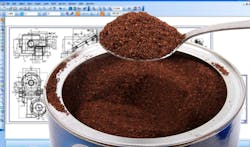“Re-Caffeinate” a Radar System Design
An article published in 2012 described how to build a synthetic aperture radar using a laptop coffee-can radar system. A few years later, Dr. Jim Carroll and Dr. Gent Paparisto decided to redesign the radar system by taking advantage of the capabilities of the NI AWR Design Environment. In the application note, “OCW Coffee-Can Radar Optimized in NI AWR Software,” National Instruments describes how the original coffee-can radar system was redesigned with better performance and lower cost. The NI AWR Design Environment was used to design the new system.
The original coffee-can radar system operated in the 2.4-GHz industrial, scientific, and medical (ISM) frequency band. That design used readily available connectorized components. The baseband information was extracted with a laptop sound card. MATLAB was utilized to perform the necessary processing.
The new “re-caffeinated” radar system design was achieved by taking advantage of the capabilities of the NI AWR design software. The new system design ultimately achieved improved performance in a reduced footprint while also lowering costs. First, the original design was created in the Visual System Simulator (VSS) software. Next, a redesigned system was also created in VSS. While this new system essentially had the same topology as the original, surface-mount parts were used in place of the original ones. Furthermore, the original coffee-can antennas were replaced with Vivaldi antennas.
The application note presents the VSS system-level analysis of both the original and new designs. The new design demonstrated that it could transmit greater output power than the original, due much in part to a better performing power amplifier (PA). In addition, the intermediate-frequency (IF) power spectrum is shown for both designs. These simulations were performed with a frequency-modulated-continuous-wave (FMCW) signal propagating through the respective systems. Time-domain simulations of target distance and velocity are presented as well.
The radar system was built on a 62-mil-thick FR4 board. The application note also describes the Vivaldi antennas, which replaced the original coffee-can antennas. Finally, a photo of the complete system is shown.
AWR Corp., 1960 E. Grand Ave. Suite 430, El Segundo, CA 90245; (310) 726-3000

